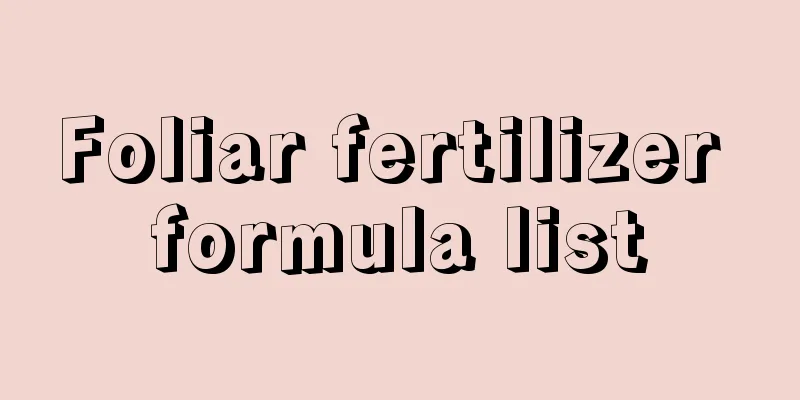Foliar fertilizer formula list

|
The success of crops depends on good fertilizer. If you want crops to grow well, you must pay attention to the supplement of foliar fertilizer . Many people don’t know how to match foliar fertilizer. Let’s take a look at the list of foliar fertilizer formulas below. 1. Potassium dihydrogen phosphate + brassinolide The combined application of potassium dihydrogen phosphate and brassinolide is the most commonly used formula in agricultural production. Mixed spraying can significantly increase the yield and quality of crops. Spraying during the initial flowering period and fruit expansion period of fruit trees can increase the yield by 30% to 40%; spraying during the young fruit stage of Solanaceae vegetables can increase the yield by more than 40%; spraying during the expansion period of the fleshy roots of radishes and carrots can make the root tubers smooth and increase the yield by 30% to 50%; spraying during the peak flowering period and podding period of beans can increase the yield by 35%. For each acre, you can use "50 grams of potassium dihydrogen phosphate + 10 ml of 0.01% brassinolide", diluted with 20 kg of water for spraying, spray once every 7 to 10 days, and spray 2 to 3 times in a row. . 2. Potassium dihydrogen phosphate + urea Spraying a mixture of potassium dihydrogen phosphate and urea can quickly supplement the three elements of nitrogen, phosphorus and potassium for the plants, effectively prevent the plants from being "deficient in fertilizer" and effectively prevent the plants from aging prematurely. Per acre, you can use "50 grams of potassium dihydrogen phosphate + 50 grams of urea", add 20 kilograms of water and spray it on the leaves, spray once every 7 to 10 days, and spray 2 to 3 times in a row. 3. Potassium dihydrogen phosphate + brown sugar The combination of the two can promote the growth of strong plants, increase production and improve quality, and can also prevent diseases, alleviate frost damage and pesticide damage. When using, spray at a concentration of 0.2% (seedling stage) - 0.3% (middle and late stages) of potassium dihydrogen phosphate + 0.5% of brown sugar, or spray at a dosage of 50 grams of potassium dihydrogen phosphate + 100 grams of brown sugar + 60 kilograms of clean water per mu. The continuous spraying frequency is 2-3 times, and the spraying interval period is 5-7 days. 4. Potassium dihydrogen phosphate + amino acid calcium Potassium dihydrogen phosphate + amino acid calcium can supplement phosphorus, potassium and calcium, which can not only prevent cracked fruits, soft fruits and rotten fruits, but also improve the hardness and storage and transportation resistance of the fruit. According to the compound concentration of 0.3% potassium dihydrogen phosphate + 0.1% amino acid chelated calcium, spray it on eggplant and fruit vegetables and fruit tree crops from the young fruit expansion period to the maturity period, spray once every 7-10 days, and spray continuously 2-3 times. It should be noted that if you really cannot buy amino acid chelated calcium, you can also use sugar alcohol chelated calcium or EDTA chelated calcium, but try to avoid using calcium nitrate, calcium chloride, superphosphate, etc. as they are prone to antagonistic reactions. 5. Potassium dihydrogen phosphate + chlormequat Chlormequat can inhibit cell elongation, making the stems of plants shorter and thicker, and can effectively prevent the plants from growing excessively. During the initial flowering stage of potatoes, the fleshy root expansion stage of potatoes, and the young fruit stage of tomatoes and peppers, we can use "50 grams of potassium dihydrogen phosphate + 20 ml of dwarfing agent" per acre, diluted with 20 kilograms of water for foliar spraying. This can prevent the plants from growing excessively and promote the rapid expansion of fruits and tubers. 6. Potassium dihydrogen phosphate + glucose Glucose is a monosaccharide and a product of photosynthesis. Spraying a mixture of "potassium dihydrogen phosphate + glucose" can significantly increase the efficiency of photosynthesis. The stronger the photosynthesis, the more organic matter is synthesized. In addition, spraying "potassium dihydrogen phosphate + glucose" during the fruit color change period can make the fruit brighter in color and the fruit sweeter. At any growth stage of the crop, we can use "50 grams of potassium dihydrogen phosphate + 30 grams of glucose" per acre, diluted with 20 kilograms of water for foliar spraying. That’s it |
<<: How to take care of the newly bought cactus
>>: How to take care of the newly bought money tree
Recommend
Ginseng fruit cultivation methods and precautions
1. Maintenance methods 1. Temperature: Ginseng fr...
What are the cultivation methods and precautions of mulberry leaf peony
Growth habits of mulberry leaf peony Mulberry-lea...
Can lettuce be grown in winter?
Lettuce prefers a cool environment and is not col...
Can the leaves of the lucky tree survive after being freeze-dried?
1. Can I still live? This type of plant does not ...
Method for germinating Polygonatum sibiricum seeds
1. Seed collection and cleaning The seeds of Poly...
How to grow Chinese evergreen so that its leaves are round and big
1. Soil The soil should be selected appropriately...
The role and efficacy of golden diamond flower
1. Cleansing effect Its leaves are very evenly di...
When is the best time to plant chrysanthemums?
Chrysanthemum has rich symbolic meanings and impl...
How to prune cactus
When to prune cactus It is best to prune cacti in...
Preparation method of white palm soil
Soil requirements for white palm 1. Likes acidic ...
Jasmine fertilization method
Does potted jasmine need fertilizer? Some notes o...
How to grow hydrangea
1. Flower Pot Hydrangeas are relatively large in ...
When and how to change the soil of lemon
Lemon soil change time Lemon is suitable for chan...
How to grow banyan trees
1. Breeding methods 1. Light: It is suitable for ...
Can succulents be grown in nutrient soil?
Can I grow succulents on the gravel used on the c...









